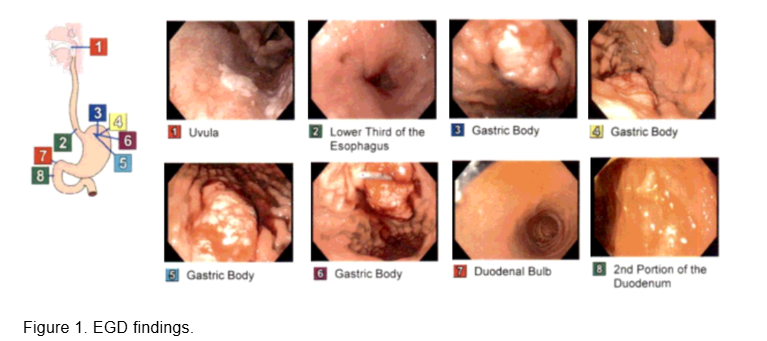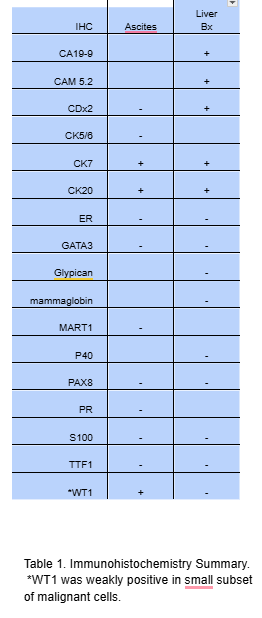Sunday Poster Session
Category: Stomach and Spleen
P2115 - Silent Progression: A Case of Advanced Gastric Adenocarcinoma Without Warning Signs
Sunday, October 26, 2025
3:30 PM - 7:00 PM PDT
Location: Exhibit Hall
- SA
Sami Aljabban, MD
Northwest Healthcare Tucson
Tucson, AZ
Presenting Author(s)
Mona Sheikh, MD, MPH, Sami Aljabban, MD
Northwest Healthcare Tucson, Tucson, AZ
Introduction: Gastric adenocarcinoma remains a leading global cancer burden, with over 1 million new cases and 11,130 deaths annually in the U.S. alone. Despite advances in screening and biomarker testing, most cases in Western countries are diagnosed at advanced stages, often due to vague or absent symptoms. This case highlights a rapidly progressive, metastatic gastric adenocarcinoma in a middle-aged woman without identifiable risk factors or classic alarm symptoms, underscoring the diagnostic challenges and need for heightened clinical suspicion.
Case Description/
Methods: A 51-year-old woman with a history of hyperlipidemia and prediabetes presented with five days of non-specific epigastric discomfort described as heaviness. She denied weight loss, melena, hematemesis, or early satiety. Her BMI was 30 kg/m² and she followed a standard Western diet. She had no history of H. pylori infection, smoking, alcohol use, or NSAID exposure. A colonoscopy 16 months prior was unremarkable.
CT abdomen/pelvis revealed diffuse hepatic nodularity, omental caking, and moderate ascites. RUQ ultrasound confirmed multiple liver masses, the largest measuring 4.4 cm. Diagnostic paracentesis showed malignant ascites with SAAG of 0.5 g/dL and high protein (4.1 g/dL). Tumor markers were notable for CA 19-9 of 4563 U/mL, CEA 7.7 ng/mL, and CA-125 227 U/mL.
Ultrasound-guided liver biopsy revealed poorly differentiated adenocarcinoma with glandular features. Immunohistochemistry showed CK7+/CK20+/CDX2+, suggestive of upper GI origin. Upper endoscopy revealed a large ulcerated mass in the gastric cardia; biopsy confirmed moderately differentiated gastric adenocarcinoma. No prior symptoms or alarm features preceded this diagnosis. A tunneled peritoneal catheter was placed, and the patient was referred for oncology care.
Discussion: This case illustrates the silent yet aggressive progression of gastric adenocarcinoma in a low-risk patient with no weight loss, anemia, or prior dyspepsia. Rising incidence of young- and middle-age onset gastric cancer, particularly in women, challenges current screening paradigms, which prioritize high-risk or high-incidence populations. Emerging literature suggests that early-onset cases may differ molecularly and clinically, necessitating tailored diagnostic approaches. CA 19-9 may serve as a helpful adjunct in identifying gastrointestinal malignancy in the context of malignant ascites.

Figure: Table 1. Immunohistochemistry Summary.
*WT1 was weakly positive in small subset of malignant cells.

Figure: EGD finding
Disclosures:
Mona Sheikh indicated no relevant financial relationships.
Sami Aljabban indicated no relevant financial relationships.
Mona Sheikh, MD, MPH, Sami Aljabban, MD. P2115 - Silent Progression: A Case of Advanced Gastric Adenocarcinoma Without Warning Signs, ACG 2025 Annual Scientific Meeting Abstracts. Phoenix, AZ: American College of Gastroenterology.
Northwest Healthcare Tucson, Tucson, AZ
Introduction: Gastric adenocarcinoma remains a leading global cancer burden, with over 1 million new cases and 11,130 deaths annually in the U.S. alone. Despite advances in screening and biomarker testing, most cases in Western countries are diagnosed at advanced stages, often due to vague or absent symptoms. This case highlights a rapidly progressive, metastatic gastric adenocarcinoma in a middle-aged woman without identifiable risk factors or classic alarm symptoms, underscoring the diagnostic challenges and need for heightened clinical suspicion.
Case Description/
Methods: A 51-year-old woman with a history of hyperlipidemia and prediabetes presented with five days of non-specific epigastric discomfort described as heaviness. She denied weight loss, melena, hematemesis, or early satiety. Her BMI was 30 kg/m² and she followed a standard Western diet. She had no history of H. pylori infection, smoking, alcohol use, or NSAID exposure. A colonoscopy 16 months prior was unremarkable.
CT abdomen/pelvis revealed diffuse hepatic nodularity, omental caking, and moderate ascites. RUQ ultrasound confirmed multiple liver masses, the largest measuring 4.4 cm. Diagnostic paracentesis showed malignant ascites with SAAG of 0.5 g/dL and high protein (4.1 g/dL). Tumor markers were notable for CA 19-9 of 4563 U/mL, CEA 7.7 ng/mL, and CA-125 227 U/mL.
Ultrasound-guided liver biopsy revealed poorly differentiated adenocarcinoma with glandular features. Immunohistochemistry showed CK7+/CK20+/CDX2+, suggestive of upper GI origin. Upper endoscopy revealed a large ulcerated mass in the gastric cardia; biopsy confirmed moderately differentiated gastric adenocarcinoma. No prior symptoms or alarm features preceded this diagnosis. A tunneled peritoneal catheter was placed, and the patient was referred for oncology care.
Discussion: This case illustrates the silent yet aggressive progression of gastric adenocarcinoma in a low-risk patient with no weight loss, anemia, or prior dyspepsia. Rising incidence of young- and middle-age onset gastric cancer, particularly in women, challenges current screening paradigms, which prioritize high-risk or high-incidence populations. Emerging literature suggests that early-onset cases may differ molecularly and clinically, necessitating tailored diagnostic approaches. CA 19-9 may serve as a helpful adjunct in identifying gastrointestinal malignancy in the context of malignant ascites.

Figure: Table 1. Immunohistochemistry Summary.
*WT1 was weakly positive in small subset of malignant cells.

Figure: EGD finding
Disclosures:
Mona Sheikh indicated no relevant financial relationships.
Sami Aljabban indicated no relevant financial relationships.
Mona Sheikh, MD, MPH, Sami Aljabban, MD. P2115 - Silent Progression: A Case of Advanced Gastric Adenocarcinoma Without Warning Signs, ACG 2025 Annual Scientific Meeting Abstracts. Phoenix, AZ: American College of Gastroenterology.
